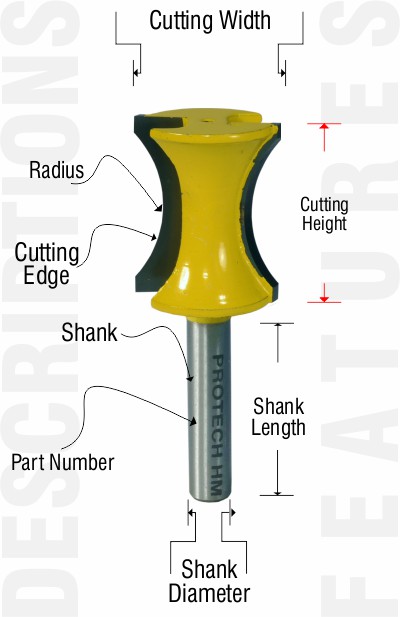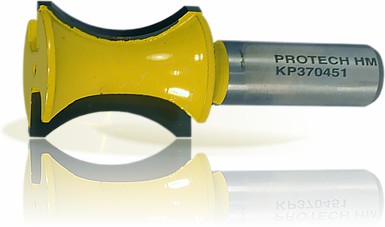
- Stock: In Stock
- Brand: PRO-TECH
- Model: KP370451
- Weight: 0.10kg
- Dimensions: 44.00cm x 34.00cm x 34.00cm
- SKU: KP370451
- UPC: 6009600403635
- MPN: 1
 Internal
Bull Nose Bit
Internal
Bull Nose Bit
 Carbide
Tipped
Carbide
Tipped
 This
router bit is used for creating a convex shaped profile on the side of the workpiece
in one pass
This
router bit is used for creating a convex shaped profile on the side of the workpiece
in one pass
- Design helps minimize kickback
- Smooth edge requires little or no sanding before applying finish
This router bit has a 12,7 mm shank (shaft) that will fit most large routers. Please ensure that you select a router bit with a shank (shaft) size that will fit into your router collet.
PRO-TECH router bits are manufactured in Taiwan.
Router Bit Maintenance
Fortunately, this is pretty easy. The best way to prolong the life of a router bit is to keep it clean. And what you need to do varies with the type of bit.
Note: Sharpening is extremely important too.
A. No Bearings:
To clean bits without bearings, first blow off any dust. Then remove any resin that has built up. (Resin places a drag on the bit which can cause it to overheat and burn.)
Resin removers are available. It's the same stuff you use to clean your saw blades.
B. Bits with Bearings:
To clean bits with bearings, first, remove the bearing. Then clean the bit as you did with non-bearing bits.
It's important to remove the bearings because even though router bearings are 'sealed,' resin remover can sneak in and dissolve the bearing grease. If this were to happen, you would be faced with the problem of trying to lubricate a sealed bearing.
Despite the claims of bearing grease sellers, we've never had much luck with this. Once that grease is gone, just go buy a new bearing.
C. Bit Shanks:
Periodically inspect the shanks of your router bits for rust or burrs. Either of these can be removed quickly with ScotchBrite®. Left on, they can interfere with your ability to properly tighten the bit in the collet.
How Fast Should a Router be Running?
If you've got a router with variable speed, then you've got the power to improve the quality of your cut. In general, the larger the bit, the slower the speed you need. The perfect solution for dealing with varying bit sizes is a variable speed router.
Here are general guidelines for most bits:
Hand Held Router Use
| Bit size | Bit size | rpm |
| Small – 12.7 mm | 1/16' to 1/2' | 22,000+ |
| 12,7 mm – 28,6 mm | 1/2 to 1 1/8' | 14,000 - 18,000 |
| 28.6 mm – 50,8 mm | 1 1/8' to 2' | 12,000 - 14,000 |
Router Table Use
| Bit size | Bit size | rpm |
| 50,8 mm – 63,5 mm | 2' to 2 1/2' | 12,000 - 14,000 |
| 63,5 mm & larger | 2 1/2' and up | 8,000 - 12,000 |
| consider safety for your health and the people around you | |||
General safety suggestions:It is advisable to always have the following items nearby and in a good condition
|
|||
|
|
|
|
|
|
Wear Gloves
|
Eye Protection
|
Hearing Protection
|
Dust Mask
|
To use router bits safely (and to get the best results from your router), the router bits need to be installed properly into the router's collet. Improper installation of your bits can cause excessive chatter and could increase the likelihood that the bits will break when in use.
Clean and sharp
First of all, before beginning any routing operation, check your bits to make sure that they are clean, relatively free of pitch, and most of all, sharp. If the bit is dull, chipped, is excessively burned or has any other defect, it should be sharpened or replaced before use.
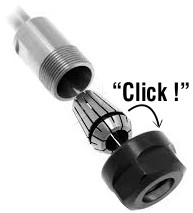 Correct
collet and collet nut fit
Correct
collet and collet nut fit
Most router collets have a recess (groove) that needs to click into a circlip that resides inside the collet nut. Failing to ensure that the collet 'clicked' into the collet nut will cause you to struggle to remove the router bit after tightening. This could cause the collet to break or be removed by a technical repair centre.
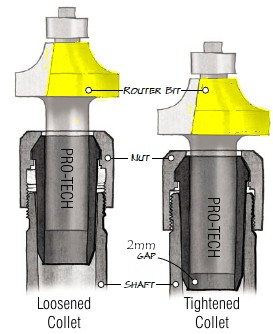 Correct
fit inside the collet
Correct
fit inside the collet
When installing the bit into the collet, do not tighten the collet with the bit 'seated.' Instead, insert the bit until the shank (bit shaft) reaches the bottom of the collet, then ease it out about 2 mm before tightening the collet.
When the bit is tightened, there should be no less than 2/3 's of the length of the shank in the collet. If your bit has a shank that is too short, then the bit should be replaced.
Safety gear
There are a few other safety measures to keep in mind whenever you use your router. First of all, remember to always wear appropriate safety gear as indicated above.
Correct speed setting
Second, be sure to set your router to the proper speed for your router bit. Setting your router to an incorrect speed will not only affect the router's performance, but also can cause the bit to break much more easily and even cause bodily harm. The speed at which a router bit turns can be important. The typical router runs at about 22,000 rpm, which is fine for most bits. But as the diameter of the bit increases, you’ll want to slow things down.
Also, before beginning any routing operation, be certain that you give the router's motor time to come up to full speed for the chosen setting. Beginning to cut before the bit is at full speed can give less than desired results.
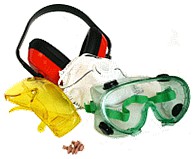 Observe
the following at all times
Observe
the following at all times
- Wear a protective face shield or Safety Glasses to prevent eye and face injury.
- Wear ear plugs or ear muffs to protect your hearing.
- Use a respirator or dust mask to give protection from dust particles. Wood dust may remain in the air for hours after using power tools.
- Always read and follow router operator's manual instructions.
- Make sure that router rpm's and the bit selected match.
- Dress properly. Wear short sleeves, no loose fitting clothes, proper footwear and no jewellery. Tie back long hair.
-
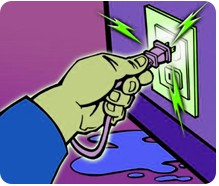 Always
be sure the router is unplugged before replacing bits and that the switch is
off before connecting the router.
Always
be sure the router is unplugged before replacing bits and that the switch is
off before connecting the router. - Be sure the router bit has completing stopped spinning before sitting the router down.
- Be sure bits, clamps and attachments are secure before starting up.
- Keep children, pets and visitors at a safe distance.
- Be especially cautious when working small pieces.
-
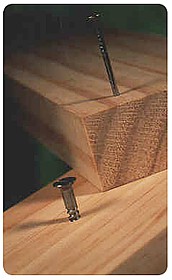 Keep
hands and fingers away from revolving bits and cutters.
Keep
hands and fingers away from revolving bits and cutters. - Do not operate routers in moist or wet areas.
- Always grip tool tightly and be prepared at start-up to resist the motor torque.
- When using a router table, make sure on/off switch is easily accessible.
- Learn the sound of your router and shut it off at any unfamiliar sounds
or irregularities.
Never start the router with the bit in contact with the material. - Always feed in the proper direction, against the direction of bit rotation.
- Maintain equipment. Replace worn parts, discard worn-out bits and check router periodically. Clean parts with appropriate solvents.
-
 Don't
operate a tool if you are tired or under the influence of medication, drugs,
alcohol or while smoking.
Don't
operate a tool if you are tired or under the influence of medication, drugs,
alcohol or while smoking. - Check wood for nails, screws or loose knots before routing.
- Keep your mind on your work, avoid distractions, work at a comfortable pace and stop before you get tired.
Do a dry run
- Place the router on the final work surface and test you cut by moving the router over the whole are to cut with THE ROUTER SWITCHED OFF
- You do not want to waste an expensive piece of wood
- You do not want to start all over
- Never met anyone with spare fingers - SAFETY
Using a Router in a Router Table
Router Table Safety
Although most router bits are small, they can be potentially dangerous and should deserve your attention and respect.
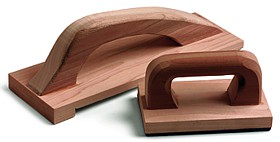 1
Use push sticks or a push block to position your hands a safe distance from the
router bit.
1
Use push sticks or a push block to position your hands a safe distance from the
router bit.
2 Use large-diameter bits only in a router table. Using bits over 25mm Ø (diameter) in a handheld router can possibly cause you to lose control of the tool and harm yourself or bystanders.
3 Always wear a dust mask as well as eye and hearing protection.
4 Take light cuts. Heavy cuts invite kickback. If necessary, move the fence closer to the bit or switch to a larger guide bearing/bush.
5 Use a featherboard (anti-kickback device) to support the workpiece against the router table and/or fence.
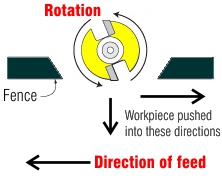 6
Never climb-cut. Always feed the stock from right to left. Against the rotation
of the router bit. (see illustration)
6
Never climb-cut. Always feed the stock from right to left. Against the rotation
of the router bit. (see illustration)
7 Avoid routing small stock. Instead, rout a larger piece and cut it to size afterwards. If you absolutely have to profile a small piece, build an suitable jig or secure the workpiece.
8 Always use a guard. If the fence didn’t come with a guard, make your own.
9 Never start the router with the bit in contact with the material.
10 Don’t force the router bit or overload the router. Excessive heat is an enemy.
11 Secure/fasten the router in the base before starting/switch on the router.
 12
Don’t bottom out the bit in the collet or partially insert the bit. Instead, completely
insert the bit, and then back off approximately 2 mm. At least 2/3
's of the router bit shank should be inside the collet.
12
Don’t bottom out the bit in the collet or partially insert the bit. Instead, completely
insert the bit, and then back off approximately 2 mm. At least 2/3
's of the router bit shank should be inside the collet.
13 Be sober and not under the influence of medicine that causes a lack of concentration
14 Tidy up your workshop to ensure the ability to move freely with enough room around the router table
Unlimited Blocks, Tabs or Accordions with any HTML content can be assigned to any individual product or to certain groups of products, like entire categories, brands, products with specific options, attributes, price range, etc. You can indicate any criteria via the advanced product assignment mechanism and only those products matching your criteria will display the modules.
Also, any module can be selectively activated per device (desktop/tablet/phone), customer login status and other criteria. Imagine the possibilities.



